
In September 2017, I received slightly over $100K as a result of the commuted value of my pension plan. I decided to invest 100% of this money into dividend growth stocks. Each month, I publish my results. I don’t do this to brag. I do this to show you it is possible to build a portfolio during an all-time high market… and stay confident during a hectic one! In the meantime, I enjoy cashing some juicy and consistent dividends!

The Scary Narrative
Please note that this article was prepared on March 6th before the bell. Of course, much more has occured since then, but the narrative is still the same.
The scary narrative is easy to understand: the virus is clogging our economy faster than it clogs our lungs. While we can all understand how any virus can slowdown the economy, finding accurate numbers is quite a challenge. I did the exercise with the influenza, a virus we have known for decades. Even then, the information I found on the U.S. wasn’t conclusive.
Molinari et al. indicated that the short-term costs and long-term burdens of seasonal influenza can amount to $26.8?~?$87.1 billion a year (source).
While indirect costs are hard to calculate, most sources tend to agree the direct cost on the healthcare system is between $10B and $11B per year in the U.S. (source)
A study from the Society for Risk Analysis published in June 2016 estimated the potential GDP loss of a pandemic outbreak to be between $34.4 billion and $45.3 billion.
Finally, the CDC made an estimate on the possible impact of a pandemic of the influenza back in 1999. The estimated economic impact could have been US$71.3 to $166.5 billion, excluding disruptions to commerce and society. Scary.
In other words, any pandemic will have an important impact on the economy, and we are talking about several billions. This outbreak comes at a time where everybody expects a market bubble to burst. The global economy was already slowing down before the virus became an issue (negative yield situation in Europe and how the Chinese economy wasn’t growing as it was before).
Many countries have taken exceptional measures to control the virus. So far, this strategy seems to be working as the number of deaths (you can’t really follow the number of new cases as many people are just not tested) isn’t growing exponentially. We still lack data, but the death rate seems to be somewhere between 1.4% and 3.4% according to the Washington Post.
While actions such as closing schools and putting entire cities in quarantine seem to be the right way to fight the virus, you can expect how it will affect the economy in 2020. As I often write, it is easy to look good on your Prom night. What we are about to see now is how companies look the next morning.
The strongest signal the market received last week was to see the central banks like the Federal Reserve and the Bank of Canada cutting their rates by not the classic 25 basis points, but by 50 points. This has rarely happened in history. Even worse, it always seems to happen during highly challenging times.
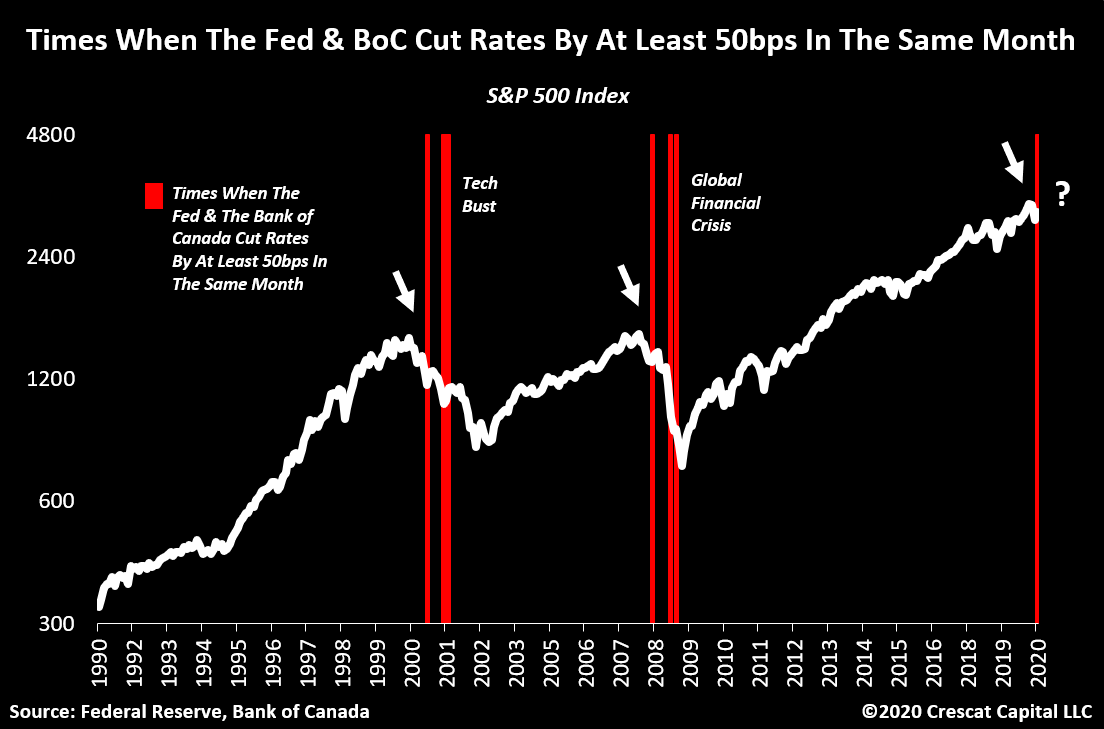
Does this mean you should sell and cash what’s remaining of your profit? Did you even consider this possibility? Selling because you are losing money should never be your sole motive. It should not be a good reason, because you are then letting your emotions govern your investments instead of your beautiful brain who built that powerful dividend portfolio in the first place. Then again, if you get out today and tomorrow the market is up 3%, what do you do? You are potentially running in circles.
For this reason, I’ve decided to upload daily videos on my YouTube channel. You can start by a video version of this income report, but there are already more to watch!
That being said, this is how you should approach your portfolio in these situations:
- Get an investing plan based on dividend growth
- Select the right sector according to your goal
- Revise your investment thesis for each holding
- Identify what’s the likelihood of a dividend cut for each holding
- Replace weaker stocks
Now let’s see how I can apply this wisdom to my own portfolio!
Revise Your Investment Thesis
When I discussed the invisible mistake we keep making, I’ve received questions from readers about my top three losers:
- Andrew Peller (ADW.A.TO)
- Lassonde Industries (LAS.A.TO)
- Magna International (MG.TO)
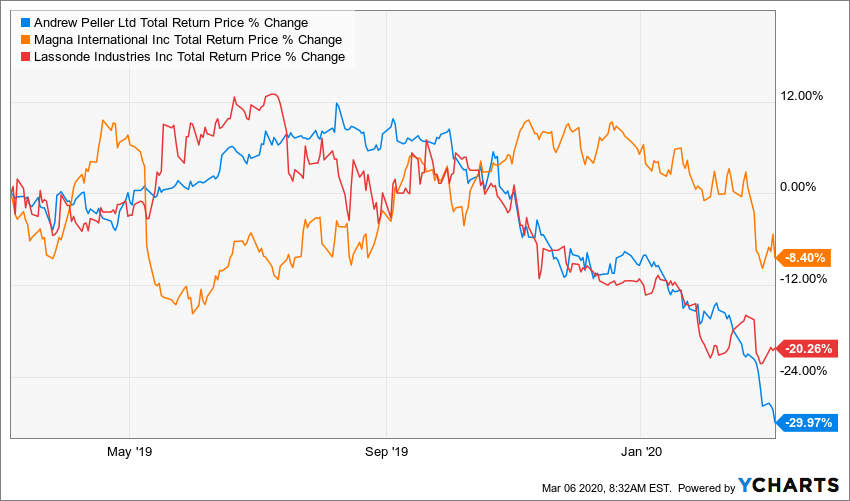
I must admit those are not looking great right now. When I wrote about waiting for a pullback, I thought about my losers too. But I don’t like to make trades purely on emotion. While I wrote this article, I took note to review my investment thesis for each company. This is what I did over the past few weeks. After reviewing each of them, I decided to let go of Lassonde.
Selling Lassonde Industries for a whooping loss!
Here was the investment thesis for Lassonde:
“Lassonde’s wide variety of brands enables it to occupy an important space in grocery stores. There aren’t many consumer products in Canada with such great metrics. LAS will continue to surf on many healthy products and to generate enough cash flow for future acquisitions. LAS recently completed a cost reduction program which should result in margin expansion. Lassonde shares’ price tumbled during the second half of 2018. Earnings are unde pressure. Higher transportation costs in the U.S. is hurting the company’s margins. Revenue growth has been mostly supported by currency tailwinds and the acquisition of OBB. This looks like a great opportunity, but shareholders must remain patient.”
Unfortunately, when I read my analysis about Lassonde, I must humbly accept that I was wrong. The company does offer great products and enjoy strong brands recognition in Canada, but Lassonde can’t grow outside acquisitions. Its expansion in the U.S. has been proven more challenging than anticipated. As the company follows a strict 25% payout ratio rule, the dividend could get cut again in 2020 as earnings may go down one more time.
I bought shares of Lassonde toward the end of 2017 at a price around $240. I sold and lost roughly $100 per share. You can now see the beauty of diversification in that trade. While I lost about 40% of my investment in Lassonde, my portfolio is still up by a wide margin. Having about 5% of my initial capital invested in LAS means that I *only* lost about $2,000. When I look at my portfolio today, Lassonde represents a loss of about 1.2% of my portfolio. It’s time to move on and find something more interesting.
Selling Apple!?!
I also decided to sell some shares of Apple. Fear not, I don’t think Apple is a sell and it remains the largest holding of my portfolio. In fact, that was the problem: I own shares of Apple in all my accounts (RRSP, LIRA and RESP). This means the weight of this company was about 13% of my entire nest egg. I decided to sell 7 shares and reduce my exposure (about 1% of all my portfolio value).
The first reason I did that was because the remaining value in Lassonde wasn’t enough to make an interesting amount of cash to reinvest. I wanted to have at least $4,000 USD to be invested (about 3.5% of my portfolio value) in my next trade. Since my shares of Apple in this account were up by about 90%, I still cashed a good profit and now I have more money to invest in my next selection!
Buy 60 shares of VF Corporation
VF designs, produces, and distributes branded apparel and accessories. Its largest apparel categories include action sports, outdoor, and workwear. Its portfolio of about 20 brands includes Vans, The North Face, Timberland, and Dickies. VF markets its products in the Americas, Europe, and Asia-Pacific through wholesale to retailers, e-commerce, and branded stores owned by the company and its partners. The company has grown through multiple acquisitions and traces its roots back to 1899. While VFC has a growth-by-acquisition strategy, it is not afraid to sell brands that do not fit into its vision anymore.
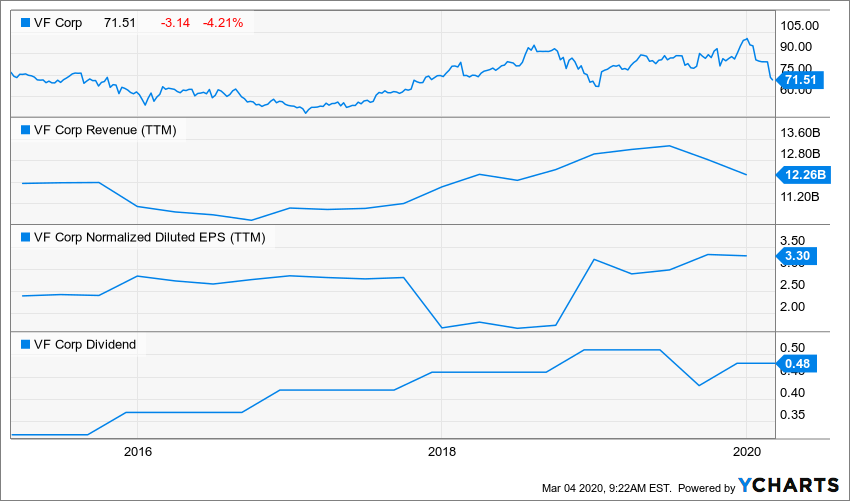
How does a glove and mitten manufacturer become a world leading outdoor and action sports apparel company with over $12 billion in sales? We are talking about active brand portfolio management. In a world where fashion evolves at a rapid pace and where brand power means pricing power, VF Corporation cracked the code. In May 2019, VFC spun off its jeans brands into Kontoor (KTB). Kontoor Brands house the Wrangler, Lee and Rock & Republic denim brands. The company has built a serious brand with incredible growth potential in Vans. We also like its focus on ecommerce and branded stores to avoid dependence on third-party retailers. It enables VF to control its brands and its message.
What’s the story now?
VFC is in the middle of the perfect storm. First, it spun-off its jeans brands into Kontoor (KTB) last year, making its earnings report hard to analyze (you will see reductions in revenue whereas there is an increase in sales for the remaining brands). Second, the company has many of its products manufactured in China and counts on Asia to show double-digit growth going forward. Management has recently stated that 60% of its owned and partnered stores in China have been temporarily closed due to coronavirus mitigation efforts. The Asia Pacific region represented 12% of the company’s revenues last year, with mainland China accounting for 6%. You can certainly imagine how bad their numbers may look next quarter.
VFC is a model of brand portfolio management. It has been doing that for decades and always with great success. I don’t doubt VFC will have a bad quarter… maybe a bad year. But overall, people won’t stop buying Vans gear and North Face winter coats.
If you prefer looking at Canadian Stocks, I also recently wrote about two companies that will have a strong rebound: Parkland Fuel (PKI.TO) and Suncor (SU.TO).
Now, let’s look at my current holdings! Numbers are as at March 6th, 2020 (before the bell):
Canadian Portfolio (CAD)
| Company Name | Ticker | Market Value |
| Alimentation Couche-Tard | ATD.B.TO | $7,480.28 |
| Andrew Peller | ADW.A.TO | $3,788.95 |
| National Bank | NA.TO | $5,303.20 |
| Royal Bank | RY.TO | $5,988.00 |
| CAE | CAE.TO | $6,688.00 |
| Enbridge | ENB.TO | $8,314.04 |
| Fortis | FTS.TO | $5,764.77 |
| Intertape Polymer | ITP.TO | $4,248.00 |
| Magna International | MG.TO | $4,307.10 |
| Sylogist | SYZ.V | $3,753.00 |
| Cash | $42.32 | |
| Total | $55,677.66 |
My account shows a variation of -$8,358.42 (-13%) since the last income report.
A big part of this drop was caused by the market, but I also transferred about $3,100 CAD into USD for my transaction with VFC. At this point, I show 4 losers in my Canadian portfolio. Andrew Peller (-24%), Intertape Polymer (-16%), Magna International (-14%) and Sylogist (-13%). Yet, the power of diversification works in my favor as my portfolio is still showing positive returns since 2017. Therefore, there are no reasons to panic!
Here’s my US portfolio now. Numbers are as at March 6th, 2020 (before the bell):
U.S. Portfolio (USD)
| Company Name | Ticker | Market Value |
| Apple | AAPL | $7,030.08 |
| BlackRock | BLK | $6,614.58 |
| Disney | DIS | $5,129.10 |
| Gentex | GNTX | $6,272.15 |
| Hasbro | HAS | $3,425.62 |
| Lazard | LAZ | $3,522.66 |
| Microsoft | MSFT | $9,976.20 |
| Starbucks | SBUX | $6,476.15 |
| Texas Instruments | TXN | $5,736.00 |
| United Parcel Services | UPS | $3,440.63 |
| Visa | V | $9,348.00 |
| VF Corporation | VFC | 4,294.20 |
| Cash | $83.40 | |
| Total | $71,378.77 |
The US total value account shows a variation of -$7,905.84 (-10%) since the last income report.
Then again, Mr. Market has been harsh over the past few weeks. My total portfolio now stands at $151,440.02 (using a USD to CAD of 1.3416). Compared to exactly one month ago, we are talking about a market driven drop of 10.6% or $17,948.57.
When I do the prorated return of the SPI and XIU I get -10.43%. Therefore, it’s fair to say that I’m following the market and what is happening right now pretty much affects everybody. To be honest, if I was lagging the market by 5% or outperforming over a single month, it wouldn’t mean anything.
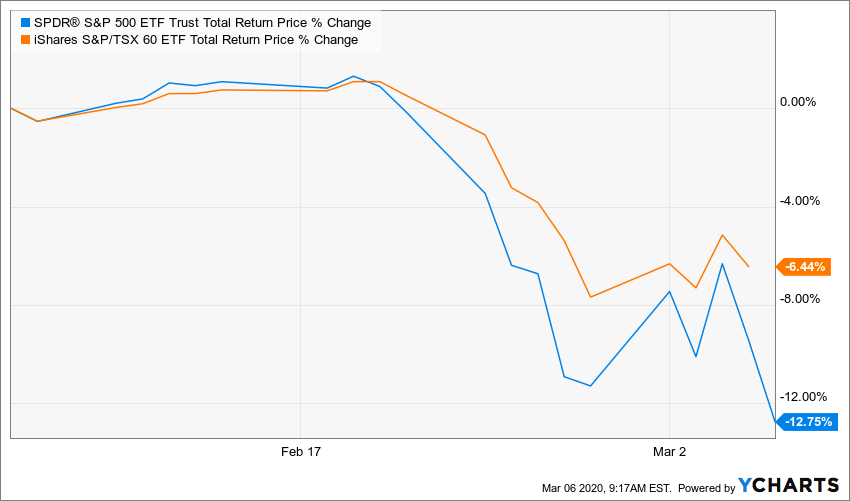
What really matters is that
- A) I reach my retirement goal of retiring happy;
- B) I get more dividend payments year after year;
- C) My portfolio beats the market over the long run.
My entire portfolio quarterly updated!
Each quarter, we run an exclusive report for Dividend Stocks Rock (DSR) members who subscribe to our very special additional service called DSR PRO. The PRO report includes a summary of each company’s earnings report for the period. We have been doing this for an entire year now and I wanted to share my own DSR PRO report for this portfolio. You can download the full PDF giving all the information about all my holdings. Results have been updated as of December 2019.

Download my portfolio Q4 2019 report.
Dividend Income: $365.23 CAD (+34.85%)
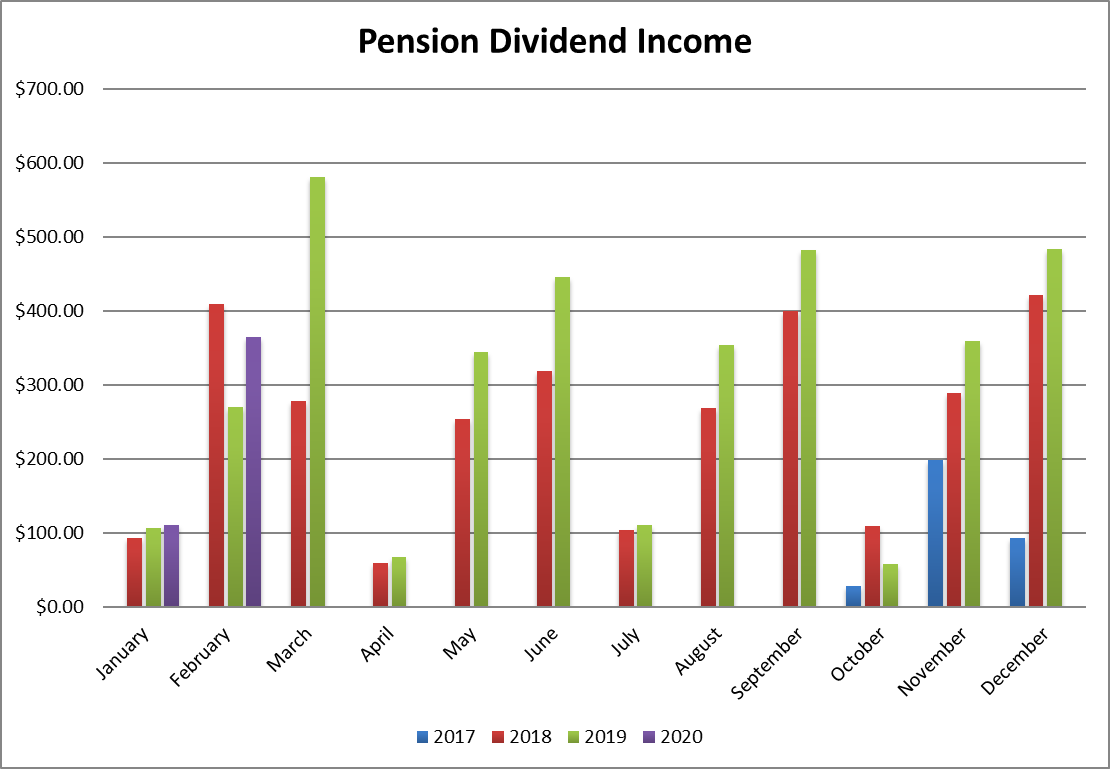
Don’t cheer just yet, I didn’t get a 35% dividend increase this month. There were some companies paying in February or on March 1st in the past and this happened again. Here is the dividend growth detail. The growth is compared to February 2019 (not necessarily a recent dividend increase):
- National Bank: +9%
- Royal Bank: +7%
- Texas Instruments: +16.9%
- Apple: +5.5%
- Hasbro: +7.9%
- Starbucks: +13.9%
- Lazard: was paid in March last year.
Canadian Holdings payouts: $119.80 CAD
- National Bank: $56.80
- Royal Bank: $63.00
U.S. Holding payouts: $182.94 USD
- Texas Instruments: $45.00
- Apple: $23.87
- Hasbro: $31.28
- Starbucks: $34.85
- Lazard: $47.94
Total payouts: $365.23 CAD
*I used a USD/CAD conversion rate of 1.3416
Since I started this portfolio in September 2017, I have received a total of $7,465.42 CAD in dividends. Keep in mind that this is a “pure dividend growth portfolio” as no capital can be added into this account. Therefore, all dividend growth is coming from stocks and not from additional capital.
Final Thoughts
I know you are probably very frustrated to see thousands of dollars disappearing from your portfolio right now. Nobody likes to lose money even if it’s “paper money”. Keep in mind that if you have a strong portfolio and you have revised your holdings, you should go through this storm without losing much. Stop your brain from trying to find trends when there are none. Trust the plan you developed at one point, it must be good!
The post February Dividend Income Report – The Scary Narrative & What to Do appeared first on The Dividend Guy Blog.
